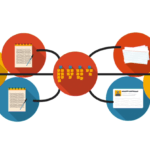Feature Ideation
This is a method of reframing known user needs, using them as inspiration for creative new features. The rapidly generated, tangible ideas generated from this can be evolved and integrated into a product feature set.
MATERIALS
Design materials (e.g, large paper, Sharpies, note cards, post its) Smallest space where the participants can cluster around a wall or board where post it notes can be placed and rearranged
Detailed steps
1. PREP
Prep is around 30-60 minutes for a 30-60 minute session. Invest in having solid information about your users their needs and your product strategy before beginning a feature ideation session. Invite a diverse audience with a multidisciplinary background, if you are over 6 people break into subgroups so everyone gets heard. Facilitator can kick off brainstorm and then participate and manage conversation, the main role of the facilitator is to steer the conversation back to specific user traits and needs.
2. FRAME
Introduce your target user and the need you are trying to solve.
- Characterize your target user in a textured, non-stereotypical way.
- Describe the need with an open question. For example, instead “let’s create a better calendar app to make user X more efficient”, using the open question: “how might we create more time in the day for user X?”
3. INITIATE
Start by reviewing ground rules for the brainstorm. In general, these are some good guidelines for an effective brainstorm:
- Defer judgement
- Encourage wild ideas
- Build on the ideas of others
- One conversation at a time
- Be visual
- Stay focused on the topic
- Go for quantity
- If you’re using post its, one per idea
4. THINK
Part 1: Divergent Thinking (⅓ of allotted time)
Rapid creation of random, unorganized, wild, free-flowing, novel ideas in a short period of time. The method is used to think outside the usual constraints, and to get comfortable with ideas that may not be immediately valuable, but could provide the required novel ingredient in driving innovation.
Part 2: Convergent Thinking (⅓ of allotted time)
Selective critique and combination of ideas in order to develop strong concepts.
The method is used to build on the strength of the ideas when they are put together. The combination force new thinking and creativity around how new solutions can be made and differentiated.
Create clusters of complementary ideas and add more texture and detail
5. SYNTHESIZE
Allow about ⅓ of the allotted time for synthesis.
- Pick 3 of the strongest clusters and refine them by imagining the scenario of usage and the social, emotional attributes your target user would experience.
- Draw 3-6 storyboards for each solution and annotate with user thinking and emotions.
Consider your three ideas and move into prototyping or discard.
Source: Mozilla


 Previous Post
Previous Post Next Post
Next Post